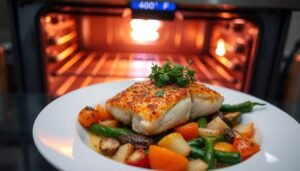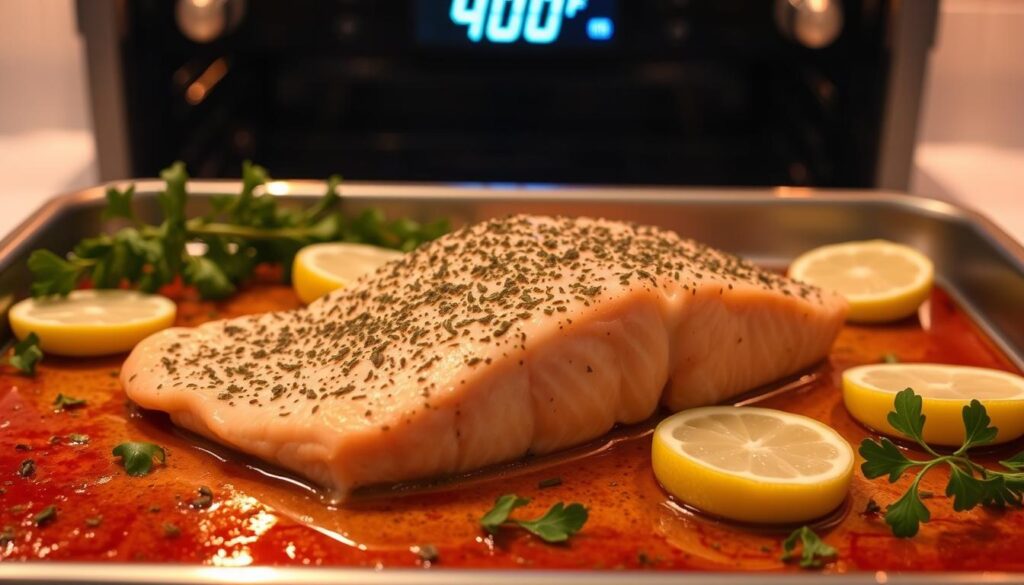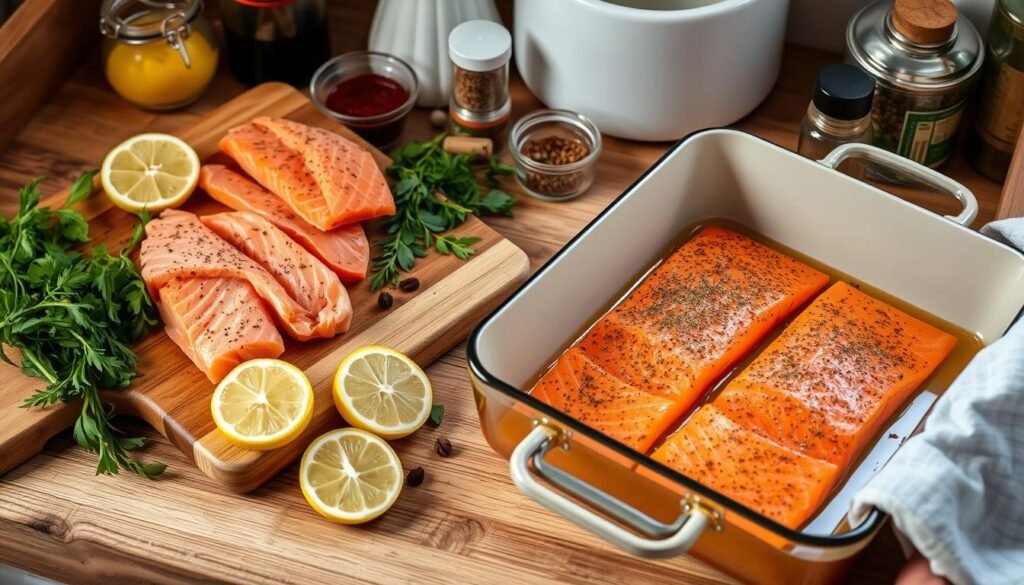The Best Fluffy Pancakes recipe you will fall in love with. Full of tips and tricks to help you make the best pancakes.

When baking salmon, it’s important to use the right temperature and time. The best temperature is 400°F. The cooking time depends on the fillet’s thickness.
For a thin fillet, bake for 8 to 10 minutes. A medium fillet needs 12 to 15 minutes. Knowing the right time and temperature is key for a great dish.
To bake salmon perfectly, consider both time and temperature. Baking at 400°F takes 10-15 minutes. Baking for 4-6 minutes per ½ inch of thickness is a good rule.
This ensures your salmon is cooked to 145°F. It will also be full of flavor.
Table of Contents
Understanding the Perfect Temperature for Baking Salmon
Baking salmon at the right temperature is key to a tasty and moist dish. The ideal temperature is 400°F. This keeps the fish moist and full of flavor. Most recipes suggest baking for 12-15 minutes, depending on the fillet’s thickness.
It’s important to be precise with the temperature. Different ovens can affect the cooking time. Always use a thermometer to check the salmon’s internal temperature. It should reach 135°F for it to be safe to eat.
When baking salmon, consider the fillet’s thickness, your oven type, and how you like it. Following these tips and using the correct temperature will help you cook perfect salmon, which is both healthy and delicious.
For instance, a citrus-based recipe can add much flavor to your salmon. The trick is to balance the ingredients and cooking time. You can make a delicious and nutritious salmon dish with some practice.
Essential Preparation Steps Before Baking
To get the perfect cooking time, you must prepare the fish right before baking it in the oven. Start by drying the fish with paper towels to remove extra moisture. This ensures that the salmon cooks evenly and doesn’t steam instead of bake.
Then, rub the salmon with olive oil, salt, and pepper. You can also add herbs and spices for more flavor. For a citrusy touch, squeeze some lemon juice or zest on the salmon. Keep your preparation quick and simple, taking about 5 minutes.
Here are some key steps to remember:
- Patch the fish dry with paper towels
- Season with olive oil, salt, and pepper
- Add herbs and spices for extra flavor
These simple steps give you the perfect salmon cooking time and enjoy a tasty baked salmon. Always check the salmon’s internal temperature to ensure it’s 145°F for full cooking.
| Salmon Type | Cooking Time | Internal Temperature |
|---|---|---|
| Fresh Salmon | 12-15 minutes | 145°F |
| Frozen Salmon | 17-20 minutes | 145°F |
Following these guidelines and preparation steps, you’ll get the perfect baking salmon in the oven and enjoy a delicious meal.
How Long to Bake Salmon at 400 Degrees
Baking salmon at 400°F is all about the cooking time. The time needed varies with the fillet’s thickness and whether it’s wild or farm-raised. Knowing how long to bake salmon at 400 degrees is key to getting it right.
Experts suggest baking salmon for 12-20 minutes at 400°F, based on the fillet’s thickness. A 1-inch thick fillet might need 15-18 minutes, while a thinner one could be done in 10-12 minutes. Wild salmon, with its higher fat content, might cook a bit differently than farm-raised.
Checking the salmon’s internal temperature is crucial to getting the perfect texture. The FDA says to cook it to 145°F, but some like it cooked to 125-130°F for a juicier texture. Letting it rest for 3 minutes before serving is also a good idea. Following these tips’ll make a delicious salmon dish that will wow your guests.
Timing for Different Fillet Sizes
- 1-inch thick fillet: 15-18 minutes
- 3/4-inch thick fillet: 12-15 minutes
- 1/2-inch thick fillet: 8-12 minutes
Knowing how long to bake salmon at 400 degrees can help you make a tasty dish. Always check the internal temperature and adjust the time to get the salmon right.
Seasoning Your Salmon for Maximum Flavor
Seasoning is key when making an oven-baked salmon recipe. For a citrus twist, you can use a dry rub or a marinade with lemon and orange juices. Salmon cooking tips say balancing flavors is important to highlight the fish’s natural taste.
Here are some seasoning ideas for a tasty dish:
- Lemon pepper: a classic that goes well with salmon
- Garlic and herbs: a savory mix that complements the fish
- Citrus and spices: a refreshing and aromatic blend that adds depth
Keep your seasoning simple and balanced. You want to enhance the salmon’s natural flavor. With these salmon cooking tips, you’ll make a mouth-watering oven-baked salmon recipe that will impress.
By following these tips and trying different seasonings, you’ll become a master at making delicious oven-baked salmon. So, get creative with your salmon cooking and enjoy the tasty results!
| Seasoning Option | Description |
|---|---|
| Lemon Pepper | A classic combination that pairs well with salmon |
| Garlic and Herbs | A savory blend that complements the fish nicely |
| Citrus and Spices | A refreshing and aromatic mix that adds depth to the dish |
Best Baking Methods and Equipment
The right tools and techniques are key when baking salmon in the oven. You’ll need a quality baking dish and some foil or parchment paper. This makes cleaning up easier and prevents the salmon from sticking.
Choosing the right baking dish is crucial. A dish that’s too small can steam the salmon instead of baking, making the dish less flavorful. On the other hand, a dish that’s too large can dry out the salmon. Find a dish that fits your salmon fillet perfectly.
Choosing the Right Baking Dish
A durable baking dish is essential for oven-baked salmon. Look for one made from stainless steel or ceramic that’s easy to clean. The dish’s size also matters as it affects cooking time and results.
Foil vs. Parchment Paper
When lining your dish, you can use foil or parchment paper. Foil is easy to clean and prevents sticking, but it can steam the salmon. Parchment paper is better for a crispy crust on your salmon.
Follow these tips and use the right equipment to get perfect results every time. Choose the right dish, use foil or parchment paper, and try different seasonings and ingredients to find your favorite flavors.
Common Mistakes to Avoid When Baking Salmon
When baking salmon, it’s important to avoid common mistakes. Overcooking is a big one, leading to dry and tasteless fish. To prevent this, keep a close eye on the salmon cooking time and ensure it reaches the correct baking salmon temperature.
Don’t let the salmon get too hot. The USDA says it should be at 145°F for medium doneness. Bake it at 325°F for even heat. The cooking time depends on the fillet’s thickness, but 10 minutes per inch is a good rule.
Undercooking is another mistake to watch out for. It can leave the fish not fully cooked. Use an instant-read thermometer to check for 145°F. Also, keep the salmon fresh by storing it in an airtight container in the fridge.

- Cooking to the right internal temperature to avoid overcooking or undercooking
- Using an instant-read thermometer to check for doneness
- Handling the salmon properly to preserve freshness
- Avoiding overcooking, which can result in a dry and flavorless fillet
By following these tips, you can bake salmon perfectly. Keep an eye on the salmon cooking time and ensure it’s cooked to the right baking salmon temperature. This will give you a moist and tasty fillet.
| Salmon Type | Cooking Time | Temperature |
|---|---|---|
| Sockeye | 10-12 minutes | 325°F |
| King | 12-15 minutes | 325°F |
| Coho | 10-12 minutes | 325°F |
Tips for Achieving Moisture and Flakiness
Cooking salmon right is all about moisture and flakiness. A great way to do this is with an oven-baked salmon recipe and a marinade. A marinade keeps the salmon moist and adds flavor. Try a citrus marinade with lemon and orange for a tangy taste.
To get the salmon right, cook it at 400°F for 12-15 minutes. This ensures flaky fillets. Letting it rest for a few minutes after cooking is key. It keeps the salmon moist and full of flavor.
Marinades and Their Effect on Cooking Time
Marinades can affect how long you cook the salmon. Adjust the time to avoid overcooking. A good rule is to cut the cooking time by a few minutes with a marinade.
Resting Period Importance
Letting the salmon rest is crucial for moisture and flakiness. It allows the juices to spread, making the salmon tender and tasty. For a big improvement, try resting it for 2-3 minutes before serving.
Follow these tips and you’ll make a moist, delicious salmon dish. Whether using an oven recipe or a new marinade, the secret is to cook with care.
Special Considerations for Different Salmon Cuts
Choosing the right salmon cut is key to a great dish. Whether it’s a whole salmon or fillets, skin-on or skinless, there are important tips. These tips will help you achieve the best flavor and texture.
Scoring the skin is crucial for the whole salmon. It ensures even cooking and prevents the skin from shrinking too much. Fillets can be cooked with or without skin, depending on your preference. If you’re cooking with skin on, make sure to cook the salmon skin-side down to keep it moist.

Some essential tips include using a meat thermometer and not overcooking the salmon. These tips and considering the cut will help you make a delicious dish. With practice, you’ll become a pro at baking salmon, easily enjoying this healthy and tasty fish.
Whole Salmon vs. Fillets
Whole salmon and fillets cook differently. Whole salmon takes longer and needs more attention even when cooking. Fillets cook quickly, making them perfect for a weeknight dinner.
Skin-on vs. Skinless Preparation
Skin-on and skinless salmon require different cooking methods. Skin-on salmon cooks with the skin down to keep it moist, while skinless salmon can be seasoned and marinated for extra flavor. Choosing the right cut and preparation method ensures a dish that suits your taste.
Professional Chef Tips for Restaurant-Quality Results
Follow expert tips to get restaurant-quality salmon. For flavor, use dry rubs and marinades. A citrus marinade with lemon and orange juice adds a bright taste.
Internal temperature is key when cooking salmon. Chefs recommend cooking to 120-125°F for a tender texture, but cooking to 145°F can dry it out.
Here are more tips for top results:
- Choose fresh, high-quality ingredients, like wild-caught salmon and fresh citrus.
- Don’t overcook the salmon. Cook until it reaches the right temperature, then rest it.
- Season with paprika, garlic powder, and dried herbs for extra flavor.
Follow these expert salmon baking tips and use a great oven-baked salmon recipe. You’ll get restaurant-quality results at home. These tips are perfect for any meal, big or small.
| Internal Temperature | Texture |
|---|---|
| 120-125°F | Tender and flaky |
| 145°F | Dry and tough |
Conclusion: Mastering the Art of Baking Salmon
Baking salmon at 400°F is the secret to a moist and flavorful dish. Whether new to cooking or experienced, baking salmon well takes practice. Following the tips in this guide, you’ll make salmon that wows everyone.
The ideal baking time for salmon depends on its thickness. Thinner fillets bake for 8-10 minutes, while thicker ones take 18-20 minutes. Check the salmon’s internal temperature and look for a flaky, opaque look to know it’s done. Also, try different seasonings and marinades to create your salmon recipe.
Now, you can bake salmon at 400°F like a pro. Each dish will be a hit, filled with delicious flavors. Enjoy the process, try new recipes, and feel proud of your salmon-baking skills.
FAQ
What is the ideal temperature for baking salmon?
The ideal temperature for baking salmon is 400°F.
How does the temperature affect the texture and flavor of baked salmon?
Baking salmon at 400°F makes it moist and flavorful. The high heat seals in juices and boosts the salmon’s taste.
How do different oven types impact the baking time of salmon?
Ovens, like convection or traditional, change salmon’s baking time. Keeping the temperature right is key to perfect results.
What are the essential preparation steps before baking salmon?
Before baking, pat the salmon dry with paper towels. Then, season it with olive oil, salt, and pepper.
How long should you bake salmon at 400°F?
Baking time at 400°F varies by fillet size and type. A 1-inch thick fillet usually takes 12-15 minutes.
What are the best seasoning options for baked salmon?
Salmon can be seasoned with dry rubs or marinades. The right seasoning greatly affects the taste.
What are the best baking methods and equipment for salmon?
The right baking dish, foil, or parchment papercrucialucia also, where you place the salmon in the oven matters.
What are the most common mistakes to avoid when baking salmon?
Avoid overcooking or undercooking salmon. These are common mistakes that can ruin the dish.
How can you achieve a moist and flaky texture when baking salmon?
Use marinades and let the salmon rest after cooking. This ensures it stays moist and flaky.
Are there any special considerations for different salmon cuts?
Yes, baking time and method differ for whole salmon or fillets. Skinless salmon also has its own needs.
What are some professional chef tips for achieving restaurant-quality baked salmon?
Chefs use dry rubs and marinades for flavor. They also focus on presentation to make the dish look great.









